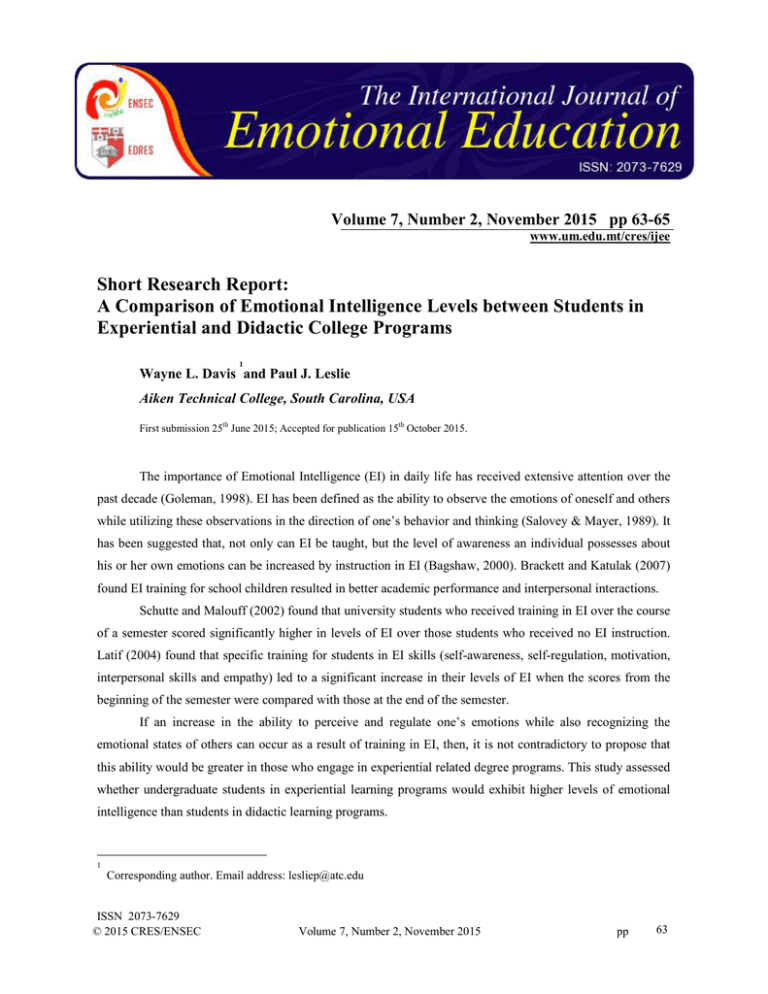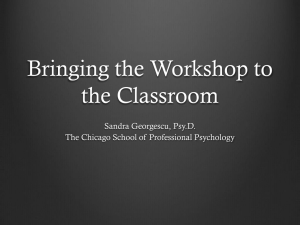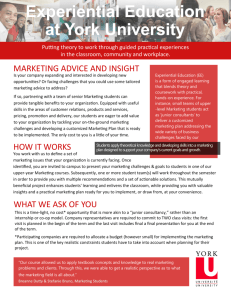Short Research Report: Experiential and Didactic College Programs
advertisement

Volume 7, Number 2, November 2015 pp 63-65 www.um.edu.mt/cres/ijee Short Research Report: A Comparison of Emotional Intelligence Levels between Students in Experiential and Didactic College Programs 1 Wayne L. Davis and Paul J. Leslie Aiken Technical College, South Carolina, USA First submission 25th June 2015; Accepted for publication 15th October 2015. The importance of Emotional Intelligence (EI) in daily life has received extensive attention over the past decade (Goleman, 1998). EI has been defined as the ability to observe the emotions of oneself and others while utilizing these observations in the direction of one’s behavior and thinking (Salovey & Mayer, 1989). It has been suggested that, not only can EI be taught, but the level of awareness an individual possesses about his or her own emotions can be increased by instruction in EI (Bagshaw, 2000). Brackett and Katulak (2007) found EI training for school children resulted in better academic performance and interpersonal interactions. Schutte and Malouff (2002) found that university students who received training in EI over the course of a semester scored significantly higher in levels of EI over those students who received no EI instruction. Latif (2004) found that specific training for students in EI skills (self-awareness, self-regulation, motivation, interpersonal skills and empathy) led to a significant increase in their levels of EI when the scores from the beginning of the semester were compared with those at the end of the semester. If an increase in the ability to perceive and regulate one’s emotions while also recognizing the emotional states of others can occur as a result of training in EI, then, it is not contradictory to propose that this ability would be greater in those who engage in experiential related degree programs. This study assessed whether undergraduate students in experiential learning programs would exhibit higher levels of emotional intelligence than students in didactic learning programs. 1 Corresponding author. Email address: lesliep@atc.edu ISSN 2073-7629 © 2015 CRES/ENSEC Volume 7, Number 2, November 2015 pp 63 Experiential programs were designated by their use of real time application of concepts which were taught in class. Programs chosen to represent experiential learning were theater, communications arts, and education. Programs were designated didactic if the focus of the program was strictly academic, textbook driven learning. The programs chosen to represent didactic learning were criminal justice and psychology. Due to the nature of the work involved with the experiential programs, in which being able to competently identify and control emotions is very important, it was hypothesized that experiential program students would exhibit higher levels of EI when compared with students in didactic programs Participants in this study included 102 undergraduate students enrolled in a Mid-West liberal arts 4year college. The students were categorized into one of two groups based on the learning style that their program stressed: experiential learning or didactic learning. According to college faculty and the school catalog, a major part of the theater, education, and the communications arts programs require hands-on application based interactions. On the other hand, most of the courses in the criminal justice and psychology programs require passive learning (i.e. lecture-based, textbook driven classes). Fifty-one students were in programs that stressed experiential learning (23 theater, 12 communications arts, and 16 education students) and fifty one students were in programs that stressed didactic learning (42 criminal justice and 9 psychology students). The students self-identified their age (range = 18-45 years) and gender (51 males, 51 females). Participants were provided with the Emotional Intelligence Scale (Schutte, Malouff, Hall, Haggerty, Cooper, Golden & Dornheim, 1998), a 33 question scale, to determine if there is a significant difference between levels of EI among students in application-based programs and non-application-based programs. An independent-samples t test was used to assess the difference between EI and college program types. The emotional intelligence scores were measured for all 102 students. The total sample mean was 128.53 (SD = 15.21) with a mean of 129.57 (SD = 15.63) for females and 127.49 (SD = 14.87) for males. An independentsamples t test was used to assess the difference between EI and college program type. The assumptions of independence and normality were met. The Levene’s test was not significant and equal variances between the groups are assumed. As predicted, there was a significant difference in the emotional intelligence scores between students in the experiential and didactic programs. Students in experiential programs displayed a higher level of emotional intelligence (M=132.53, SD=15.27, SE = 2.14) than did students in the didactic programs (M=124.53, SD=14.20, SE = 1.99); t(100)= -2.74, p ≤ .05, one-tailed. The effect size was large (d = .543) and the power of the statistical test was very good (power = .859). The findings of this study indicate that students who are enrolled in experiential programs that place more emphasis on hands-on training had a higher level of emotional intelligence than students who are enrolled in programs that place more emphasis on passive learning. Unlike the didactic programs, the experiential programs stress interactions in which students are trained to develop relationships with the community. Some of the skills that students who are in the experiential programs learn are to perceive and control behaviors, to communicate verbally, to perform their jobs professionally (e.g. to make a good impression to others), and to methodologically investigate problems (e.g. to overcome barriers). Each of these factors was assessed on the Emotional Intelligence Scale and may explain the study’s test results. In short, the hands-on experience that the students receive may be the factor that distinguishes their level of EI ISSN 2073-7629 © 2015 CRES/ENSEC Volume 7, Number 2, November 2015 pp 64 from students who do not receive the same level of hands-on training. Thus, a practical implication is that emotional intelligence can be purposively reinforced via training. Due to this being a preliminary study, further studies need to be conducted to determine whether or not higher levels of EI are developed during the participation in experiential coursework or if it is an inherent difference in individuals who chose experiential programs as a major area of study. If experiential coursework can develop higher levels of EI in comparison to individuals enrolled in didactic programs, then the EI of experiential program students who are entering the program should be compared to the EI of experiential students who are graduating from the degree program. Longitudinal studies also need to be conducted to assess the relationship between emotional intelligence and future job performance. If relationships do exist, then perhaps an emotional intelligence assessment tool can be used in career counseling settings as well as by education, theater and communications related jobs as an employment screening device. References Bagshaw, M. (2000). Emotional intelligence: Training people to be affective so they can be effective. Industrial and Commercial Training, 32 (2), 61-65. Brackett, M.A. & Katulak, N.A. (2007). Emotional intelligence in the classroom: Skill based training for teachers and students. In J. Ciarroch & J. D. Mayer, (Eds.), Applying Emotional Intelligence: A Practitioner’s Guide (pp.1-27). New York: Psychology Press. Goleman, D. (1998). Working with Emotional Intelligence. London: Bloomsbury. Latif, D. A. (2004). Using emotional intelligence in the planning and implementation of a management skills course. Pharmacy Education. 4 (2), 81-89. Salovey, P. & Mayer, J. D. (1989). Emotional Intelligence. Imagination, Cognition and Personality, 9 (3), 185-211. Schutte, N. S. & Malouff, J. M. (2002). Incorporating emotional skills in a college transition course enhances student retention. Journal of the First-Year Experience and Students in Transition, 14, 7-21. Schutte, N. S., Malouff, J. M., Hall, L. E., Haggerty, D. J., Cooper, J. T., Golden, C. J. & Dornheim, L. (1998). Development and validation of a measure of emotional intelligence. Personality and Individual Differences, 25 (2), 167-177. ISSN 2073-7629 © 2015 CRES/ENSEC Volume 7, Number 2, November 2015 pp 65


